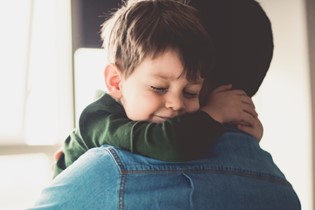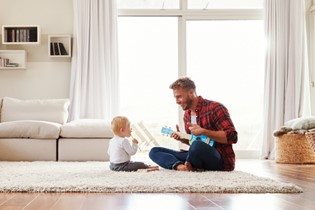How does the modern family have fun?

How does the modern family have fun? Sarah Tennant looks for the happy medium between hard work and play.
Spot check: when was the last time you and the kids had fun together? To clarify, I don’t mean the children having fun while the parents watch, or the parents enjoying themselves while the kids tag along. I mean the whole family doing the same activity in the same place at the same time – and liking it.
Maybe you can think of many occasions when you and your progeny romped through fields of daisies blowing bubbles or had tickle-fights in piles of autumn leaves.
Or maybe, like most of us, you are guiltily aware that your latest trip to the park was cancelled due to a last-minute tantrum; that you hid in the bathroom when your three-year-old wanted you to play shops; and that the board game you gave the kids for Christmas still hasn’t been played with because you can’t be bothered.
Fun can be hard work. Somewhere along the line it was decided that parents should provide fun – as though by feeding, educating, clothing and housing our children we’d turn them into joyless automatons unless we also shaped their pancakes into bunny rabbits.
Then kindergartens, corporations and Pinterest got involved, and now mandatory whimsy is being pressed upon us from all directions: think Crazy Hair Day, Pyjama Day, Superhero Day, Elf on the Shelf and Halloween costumes. And there are those poems and blog posts warning us that if we don’t drop that dishcloth to tickle our toddler, we’ll wake up in a cold sweat when we’re 80, fully regretting it.
GOOD OLD-FASHIONED WORK
Peer pressure aside, deep down, most of us decided to have kids on the premise that we’d enjoy it, so it doesn’t seem unreasonable to expect a bit of fun. So why is it so hard? I suspect a large part of the problem is that we’ve flipped the script on fun. Throughout most of history families had fun in two ways: through work, which was done as a whole family, and through play, which was age-segregated. Kids played with other kids (marbles, frog-catching), adults played with other adults (chess, darts). A great example is the life of Laura Ingalls Wilder, whose autobiographical series of Little House on the Prairie books were based on her childhood in an American settler and pioneer family. She and her siblings spent an impressive amount of quality time with their parents, and they had great fun together, but the fun was had while doing productive household chores, not as a separate leisure activity. Ma and Pa didn’t play dolls or cricket with the girls: they picked blackberries with them, made cheese, planted vegetable gardens and baked pies. When it came to playtime, the girls were on their own. (The exception was roughhousing, which I’ll get to later.)
Blame the Industrial Revolution, child labour laws, working mothers, labour-saving devices or whatever you like, but families don’t tend to work together as much any more. Sure, we’ll collaborate on decorating the Christmas tree and maybe even on setting the table, but that doesn’t offer quite the same opportunity for togetherness as pitching in to build a log cabin. In fact, these days we consider it borderline cruel to make young children do too much housework. We feel that childhood should be for play.
That’s a pity, because toddlers in particular love helping with chores. For young children, fun isn’t so much about the actual activity, it’s about the interaction. As long as I’m chatting pleasantly with my three-year-old, he’ll be as enthused about unloading the dishwasher as he is about playing with toys. Probably even more so, because he loves being able to gleefully tell Daddy how he was helpful.
According to the ‘Maya method’ (named after the in-depth studies of the Mayan culture by American psychologist Barbara Rogoff), getting toddlers to help is key to ending up with helpful older children: if you miss the ‘I want to do everything Mummy does’ window, it’s much harder to introduce chores later on.
Of course, some chores are naturally more fun than others. Every red-blooded preschooler loves squirting vinegar on a window to prepare it for being washed; picking up her toys, maybe not so much. In these situations, a spot of gamification can make the mundane fun. Nothing fancy, try ‘throw the socks in the hamper’, ‘pick up toys until the music stops’, ‘Simon says’ or ‘put away all the red things’. If you have multiple kids, make it a competition. It was a happy day when I discovered my two eldest kids would happily one-up each other over who could put away more toys.

MODERN DAY PLAY
Once upon a time, children’s play was something done strictly with other children, usually outdoors so Mother could get on with the ironing. Play wasn’t fetishised as a tool for psychosocial development, it was just what kids did when their parents were sick of them.
Nowadays we don’t tend to want our children running amok with the neighborhood urchins until dark. At the same time, we believe play, and especially imaginative play, is vital for kids’ brains. So we become their playmates, martyring ourselves to attend Barbie’s fourteenth wedding.
And it is martyrdom. Google ‘I hate pretend play’ and you’ll find numerous blogs written by mothers confessing a visceral and loathing revulsion for make-believe. As one (anonymous) mother wrote, “I like to read to my kids, take them to the park or the zoo, cook with them, listen to music and dance, do art, etc., but I HATE pretend play.” Blogger Kate at Barefoot Daydreams adds: “At my house, pretend play consists of some SERIOUS BOSSINESS where one nameless four-year-old tells everyone who to be, what to do, what to say, how to say it, how many times to say it, no don’t say it like that, say it like this, Mommy your voice is too high, no Mommy your voice is too low, you were supposed to sing that part, why don’t we own a Beast mask Mommy, mind-numbing demands. Let’s be clear – only one person is pretend playing during pretend play here. For everyone else, it’s this super fun game called Strict Adherence.”

Well, there is good news: not only do you not have to play pretend with your kids, an argument can actually be made that you shouldn’t! Pretend play is indeed valuable, but that’s because it’s usually played with another child who will push back, do it wrong, have contradictory ideas and generally demand compromise. Think of it as improv theatre: a delicate dance in which two competing imaginations have to work together to create a single shared reality. That doesn’t work if the second role is played by Mummy, who meekly follows the script her child lays out. As an article in Psychology Today says, “In make-believe play, any child playmate prevented from taking a creative part would protest immediately, and if the protest wasn’t successful, would quit. The ability to express displeasure, to rebel, to quit, is what makes play such a powerful vehicle for social learning... When we allow children to dominate us in play, to be inattentive to our needs and desires, we destroy play’s social value.” In other words, play make-believe with your kids if you actually enjoy it, but make sure you sometimes call the shots.
This principle also applies to other kinds of fun. We parents could benefit from the same advice we give scrapping children: “It’s not fun unless everyone’s having fun”. In other words, Mummy and Daddy enduring children’s entertainment they loathe does not constitute family fun. And while you can stand it for a while, you’ll be much more keen to interact with your kids if you don’t associate them with boredom and banality!
A good place to search for family fun is in your own hobbies and skills. Show off for the kids. Draw them a fun cartoon, let them watch you do fifty push-ups, show them how you light a fire or change the car’s oil or one of those other adult skills that seem magical to a preschooler. It’s hard not to have fun when kids think you’re impressive.
Or introduce them to the things you love: your favourite music, for instance. My children are vastly happier singing along with me to 1940s wartime classics than I would be enduring The Wiggles – so we don’t listen to The Wiggles. Similarly, I like Hayao Miyazaki movies but not the Disney channel, so we watch My Neighbor Totoro, not That’s So Raven.
ROUGH IT UP
If all else fails, there is a foolproof way to have fun with children. Roughhousing – play-fights, tickling, horsie rides – is the one area of play adults and children do together. It’s not just cross-cultural but cross-species – all the most intelligent mammal species roughhouse. The reason is that roughhousing is extremely important for producing robust, socially-aware children. Rough play teaches them the difference between real threats and pretend; the boundaries of roughness, and the consequences of overdoing it; that minor injuries aren’t a catastrophe; and how a bigger, stronger person holds back when playing with smaller, weaker ones. ‘Winning’ against Dad makes kids feel confident, but Dad dominating them makes them feel secure. Roughhousing helps kids manage aggression, improves their balance and coordination, and even predicts how well they’ll adjust to school. Pretty impressive results for throwing a kid up in the air!
However, if after all this you still find it hard to have fun with your children, there’s always the introvert’s option: hide and seek, with a really good hiding spot and a Kindle.
|
BRAVE OUTINGS
|
Sarah Tennant lives in Te Awamutu with her husband and four children. They have fun by pestering garden hedgehogs, watching goats climb trees on YouTube, and congratulating themselves on having a nicer baby than anyone else.

AS FEATURED IN ISSUE 47 OF OHbaby! MAGAZINE. CHECK OUT OTHER ARTICLES IN THIS ISSUE BELOW


 Family outings can be minefields. The stress of dealing with carseats, nappy bags, water bottles and sunscreen, combined with the expectation that Fun Will Be Had, tends to result in parental rage and disappointment when the children don’t oblige. It helps to accept at the outset that even a fun day will involve, say, 15% shrieking, ingratitude, vomiting and squabbling. Try not to let it ruin the other 85%.
Family outings can be minefields. The stress of dealing with carseats, nappy bags, water bottles and sunscreen, combined with the expectation that Fun Will Be Had, tends to result in parental rage and disappointment when the children don’t oblige. It helps to accept at the outset that even a fun day will involve, say, 15% shrieking, ingratitude, vomiting and squabbling. Try not to let it ruin the other 85%.














